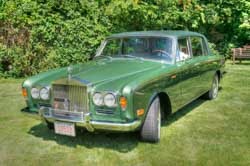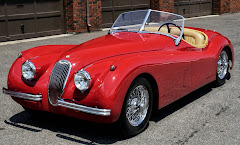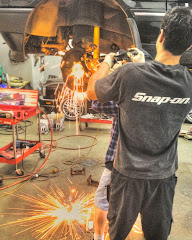Among the hundreds of thousands of cars flooded by Hurricane
Harvey there are some collector vehicles, and owners will face the challenge - what to do with them? Modern cars are usually insured, and fairly easily replaced. It can be a hardship, but there is no
fundamental barrier to replacing a 2009 Cadillac or a 2013 Toyota. Mercedes S65 AMGs may be rare and exotic, but
they are still making more of them.
What about your 1960s Barracuda or Lincoln? What about the XK120 Jaguar from the
50s? They aren’t making any more of
those, and replacement may not be an option. Even if it is insured, the car may have great sentimental value. You don't want "any" 1963 Chevy, you want the one your dad took cross country, long ago. Or maybe you are willing to get another car, but nothing comparable exists. Perhaps you just spent two years restoring that car that just went in the water . . .
At the same time, replacement may not be necessary.
 |
| Floods won't kill these old classics . . . |
The biggest killer of late model cars is corrosion of the
electrical systems. A secondary problem
is corrosion of the bodies, engines, and metal parts. Those things seldom kill vintage cars.
Newer cars are filled with computers and multi-wire
harnesses that are ruined the moment corrosion starts to bridge the gaps
between pins and circuits – often just a few thousandths of an inch. Sensor readings go awry, and systems
fail. Insurance companies have learned
through hard experience that flooded electrical systems can seldom be fixed to
stay, particularly if they have sat for a while.
If you own a vintage car that has seen flooding you will be
glad to hear that the same isn’t necessarily true for your car. Older cars have bigger and more rugged
switches that are less likely to be damaged by a little water (or a lot of
water, for that matter.) Old cars don’t
have computers, and their wiring is simple enough that we can take it apart and
clean it.
In a new car the alternators, starters, window motors and
other electrical bits are not serviceable.
They are replaceable. The problem is cost. Replacing
every electric motor and sensor in the most basic Toyota will cost thousands. Doing the same in a Mercedes S-Class will
cost tens of thousands.
Old cars are totally different. We can dismantle and clean every motor and
switch in a sixties car and the parts bill probably won’t be but a few hundred
dollars. We may need a week’s worth of
time but we CAN do it, and the job will last.
Older cars are far more repairable than the cars of today.
Where a new car may have a $2,000 instrument cluster old
cars tend to have individual gauges.
Even when water damaged they are almost always repairable at
comparatively modest cost.
Old cars tend to have much simpler interiors, which means it’s
a lot easier to strip everything out and dry it after a flood. The quicker you do that, the better.
Old cars are just as vulnerable as new cars to water getting
in the engine. If the motor floods in a
1957 Jaguar it should be pulled apart and overhauled if it's sat more than a week or two. The difference is, that job will probably
cost ½ to 1/3 what it will cost on a 2017 Jaguar.
Furthermore, the 2017 Jaguar has thousands of dollars of
ancillary parts on the engine that will be ruined by flooding. Motorized intakes. Electronic fuel injectors. Alternators.
Sensors. Each piece hundreds of
dollars and dozens of them. Those parts
do not exist on the vintage cars, and that makes the job of flood recovery
possible.
What about the interior?
I’ve seen quite a few antique car interiors – especially the wool cloth
and velour ones – come through fresh water flooding with very little
damage. We clean them with an
extraction cleaner and they are fine.
When interiors are damaged they can be repaired with upholstery
techniques that are timeless, where the interiors of new cars must be replaced
with expensive factory-made pieces.
If you own a vintage car that is in a flood remember time is
of the essence. If your engine was
filled with water last week, we can probably flush it out and get it running
next week with no major repairs. Wait
three months and you’ll be looking at an overhaul.
Another thing – if your old car goes into water, DO NOT just
start it up (or try to) If there is
water in the intake and you draw it into the cylinders you will break rods and
pistons. If water gets into an automatic
transmission it’s instant ruin to put it in drive running. Yet those systems can be drained, flushed and
put back in service with no lasting damage, if done right.
Remember that floods don’t always come from storms or snowmelts. Your vintage convertible can sustain just as
much damage with the top down in a summer thunderstorm. The thing to remember is this: Comprehensive insurance usually covers all
sorts of water damage, even if you did something dumb. Just be truthful with the insurance
company. It’s no crime, forgetting to
close a window or a roof.
Some vintage cars are even prepared for flooding. For example, we restore old Land Rovers, Land
Cruisers, and Jeeps for people on the Cape and Islands. Many of those cars spend time on the beach
and for various reasons, some of them end up in the surf. We’ve devised a number of strategies to
minimize the impact of what may in that case be “inevitable flooding.”
We use saltwater-rated marine electrical connections, and
seal all the wire junctions with liquid electrical tape. We paint or finish insides of panels and
pieces to prevent corrosion if they get wet.
We replace automotive cloth seat covers with marine fabrics like
Sunbrella and we use marine grade wood and foam underlays. Everywhere we can, we treat with Waxoyl
corrosion protection and/or POR15 paint.
 |
| Stainless hardware now holds this body in place, rather than the original bare steel |
 |
| Everything is painted or plated, and after this photo was shot, covered in Waxoyl |
Sometimes people balk at the cost of that, but the money
spent for a beach car may be repaid ten times over during the next ten
years. We can’t eliminate corrosion but
we can sure slow it down.
The simplicity of vintage cars makes it practical to repair
them after most floods. Their rarity and
value makes the effort worthwhile.
© 2017 John Elder Robison
John Elder Robison is the general manager of J E Robison Service Company, celebrating 30 years of independent Bentley, Rolls-Royce, BMW/MINI, Mercedes, and Land Rover restoration and repair in Springfield, Massachusetts. John is a longtime technical consultant to the car clubs, and he’s owned and restored many fine British and German motorcars. Find him online at www.robisonservice.com or in the real world at 413-785-1665
Reading this article will make you smarter, especially when it comes to car stuff. So it's good for you. But don't take that too far - printing and eating it will probably make you sick.


























No comments:
Post a Comment